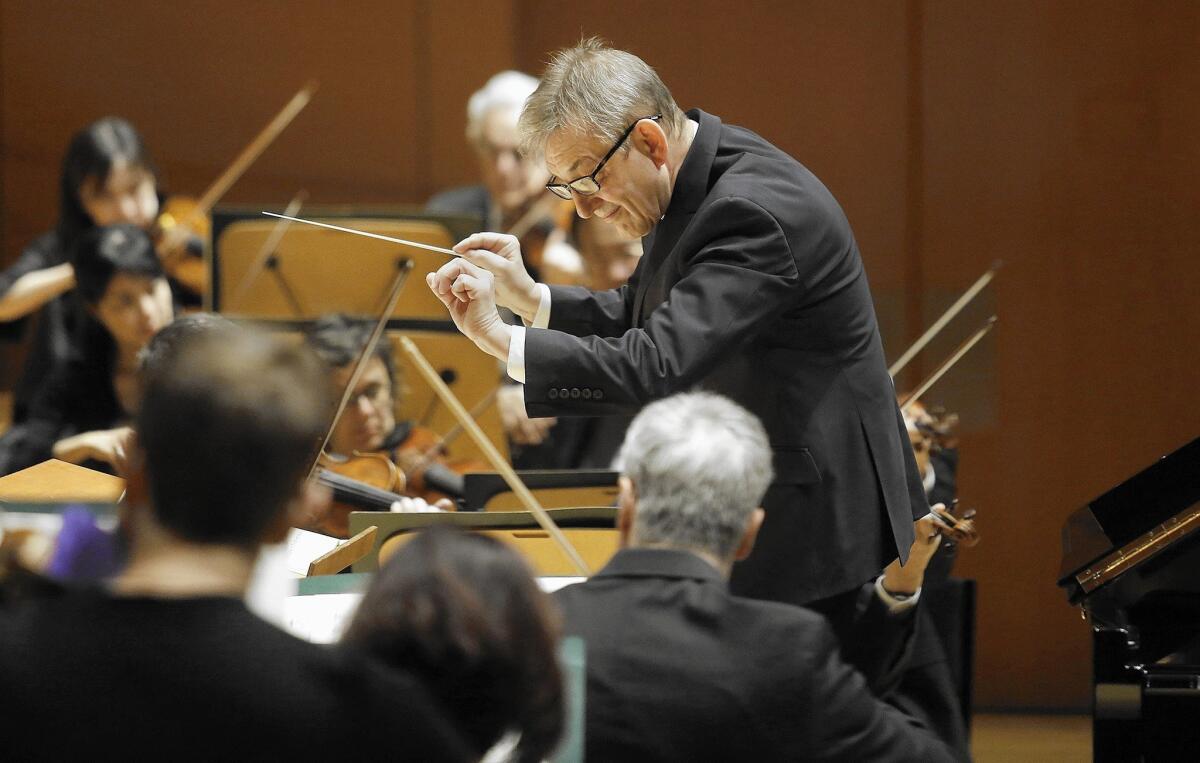Review: Pinnock, Rana fill in admirably with L.A. Philharmonic

- Share via
The Los Angeles Philharmonic does not believe in miracles.
Being an up-to-date, real-world orchestra surely helps account for its success. But being unsentimental also means that the orchestra seldom programs seasonally, instead collecting Christmas cash and Hanukkah gelt by farming out holiday concerts to popular touring ensembles and soloists at Walt Disney Concert Hall.
Still, inviting French Canadian conductor Bernard Labadie for the L.A. Phil’s last concert in December looked to have the making of a sometimes tradition. He conducted a superb rare Christmastime “Messiah” with the orchestra a decade ago. Back in 2011, he turned, though, to late Mozart.
Last weekend, Labadie was to have ended the L.A. Phil year with more Mozart, but he has now canceled all concerts for the rest of the season to undergo treatment for cancer. His replacement, Friday morning in Disney, was Trevor Pinnock, the well-known British early-music specialist making his welcome L.A. Phil debut in what was to have been the same program, pairing an early Mozart piano concert with a late symphony, both in the uplifting key of E-flat major.
But soprano Miah Persson, who was also to have sung three Mozart arias, came down with the flu. With no time to find a replacement, Pinnock filled in the program with six late German dances, written by Mozart the same time as the E-Flat Symphony.
Supposedly tossed off in an hour for a party in Prague, these dances are minor Mozart. Yet Pinnock’s choice proved a minor miracle, or at least a flabbergasting coincidence. The unsuspecting conductor told the audience of learning at rehearsal that the great-grandfather of a longtime member of the orchestra’s second violin section, Guido Lamelli, happened to have commissioned those dances from Mozart. What are the odds?
Still, there is nothing musically miraculous about Mozart’s lightweight Six German Dances, K. 505, other than the unbelievable speed at which they were written, making them essentially improvisations. On the other hand, the Piano Concerto No. 9 (“Jeunehomme”), a product of Mozart’s 21st year, is his first great piano concerto and one of the most expansive of his 27.
The soloist was Beatrice Rana, a young Italian pianist who won the silver medal, and was the audience favorite, at the 2013 Van Cliburn Competition. This is not a concerto in which to show off, and she didn’t.
Ironically, the concerto that best captures the specialness of Mozart’s youth requires a mature touch, and it has become the province of many senior soloists. But while displaying a mature quiet and lyrical surety, Rana actually had the advantage of youth.
She brought unerring grace to Mozart’s seemingly effortless, melodic inspiration and floated Mozartean figurations with lyric ease. In the slow movement, which reveals depth of feeling through harmonic experimentation, Rana didn’t make the mistake of overdramatizing. And she demonstrated that the impetuous return to high spirits in the last movement really does belong to the young.
For his part, Pinnock was full of surprises. Founder of the London-based period-instrument ensemble, the English Concert, in 1972, he has made a lasting contribution to the early music movement by helping demonstrate that what we don’t know about the Baroque era won’t hurt us. Rather than rely on dubious treatises, he has treated restricted historical knowledge about performance practices as liberating, an opportunity for creativity.
So unlike some other early music specialists who cajole modern orchestras into playing as though they still retained older instruments, such as toning down vibrato in the strings, Pinnock seemed perfectly happy to make a 21st-century sound (although principal timpanist Joseph Pereira used old-fashioned drums as he regularly does for 18th century music).
Mainly, Pinnock conducted as if he were simply happy. He is a man of upbeats. All his Mozart — the program began with the Overture to Mozart’s last opera, “La Clemenza di Tito” — had an effervescence. Tempos were spirited but not flamboyant. The E-Flat Symphony (No. 39) flowed like molten lava, a symphony of overlapping phrases and ever changing shapes.
The L.A. Phil’s playing was exquisite. One thing that is typical of early-music ensembles is their emphasis on transparency, which allows for not only clarity of inner lines but also brings out the flavorful individuality of different instruments.
This Pinnock did achieve Friday, but never unnaturally and, better still, not archaically to make the, well, miracle of Mozart manifest.
More to Read
The biggest entertainment stories
Get our big stories about Hollywood, film, television, music, arts, culture and more right in your inbox as soon as they publish.
You may occasionally receive promotional content from the Los Angeles Times.











